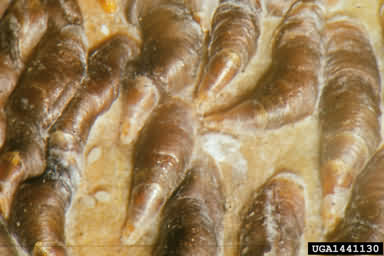Pests
Lepidosaphes ulmi L. - Mussel Scale.
Systematic position.
Class Insecta, order Homoptera, suborder Coccoidea, family Diaspididae, genus Lepidosaphes Shimer. It is realted to Lepidosaphes salicina Borchsenius.Synonyms.
Mytilococcus ulmi L., Mytilaspis pomorum Sign.Oyster-Shell Scale, Appletree Bark Louse.
Biological group.
Polyphagous pest of fruit crops.Morphology and biology.
Adult female scale length is 3-4 mm. The scale is elongated, dilated toward the posterior end, and curved in the form of a comma; it is brown in living females, dark brown in dead ones. Adult female immovable; its under-body scale is milky white in color, 1-2 mm in length. Eyes and legs absent; antennae non-segmented, tubercle-shaped; sucking mouthpart. Female lays elongated-oval, white eggs under her body and then dies; fertility is about 100 eggs. Hibernates during the stage of egg-laying. During hibernation, the eggs survive at temperatures as low as -32°C. Emergence of nymphs occurs in spring at temperatures of about 8°C, coinciding with apple blossoming. The 1st-instar nymph (crawler) yellow, flattened-oval; its body length is 0.31 mm. Antenna 6-segmented; eyes resemble black spots near antennae insertion; 3 pairs of legs (femur thickened, tibia very short, tarsus the same length as femur, claw without denticle). Crawlers live without feeding for 2 days at most. They attach to young bark by suction after settling, and their body becomes covered with a down-like substance, which later transforms into a scale. The 1st molt occurs after 10-15 days. Nymph of the 2nd instar has no eyes, antennae, and legs; its scale consists of one larval exuvia and secretions. The 2nd-instar nymph development lasts about 1 month. Adult female appears after the 2nd molt. Life cycle of male includes 4 nymphal stages. Scale of male nymph has the same shape the female.s, but smaller in size. Adult male has eyes, antennae, 3 pairs of legs, and 2 wings; its body is distinctly divided into head, thorax, and abdomen. Male body length is 0.5 mm. Bisexual and parthenogenetic (obligatory parthenogenesis) populations are known, having no morphological difference. Interbreeding between these forms is not known. Bisexual forms are characterized by more numerous host plant species and survive in more adverse weather conditions. These populations consist of about 18-36% males.Distribution.
It is a Holarctic forest species, absent in arctic and tropical territories. Introduced concomitantly with plants to Southern America and Australia. In the former USSR, it inhabits the Baltic States, Belarus, Moldavia, Ukraine, the European part of Russia, the Caucasus, Southwestern Siberia, the Irkutsk Region, the Primorskii Territory, Middle Asia, and Kazakhstan.Ecology.
Mostly monovoltine, but bivoltine in southern regions. Polyphage. More than 150 host plant species are known, including Grossulariaceae, Rosaceae, Juglandaceae, Tiliaceae, Hydrangeaceae, Salicaceae, Betulaceae, Celastraceae, Aceraceae, Elaeagnaceae, Pyrolaceae, Oleaceae, and Caprifoliaceae families. Inhabits trunks, branches, and, to a lesser degree, fruits, but is absent on leaves. Increase in colony size causes decrease of pest fertility. Population density in nature depends on the activity of entomophages, e.g., the parasite Aphytis mytilaspidis (Baron) and predator Chilocorus bipustulatus L.Economic significance.
Mainly a pest of apple, but also infests pear, plum, peach, apricot, mulberry, hawthorn, and currants. Pest of decorative and forest plants, too. Bark of plants is entirely covered with scales of the pest during its mass propagation. It causes defoliation and the dying of branches, sometimes of the entire plant. Thinning of plantations, cutting back and burning infested branches are preventive control measures against L. ulmi. Pesticide treatment is necessary in spring after mass emergence of the 1st-instar nymphs.Related references:
Batiashvili, I.D. 1959. Pests of continental and subtropical fruit crops. Tbilisi: Institut sel'skogo khozyaistva. 455 p. (in Russian).Borkhsenius, N.S. 1966. A catalogue of the armored scale insects (Diaspidoidea) of the world. Moscow-Leningrad: Nauka. 449 p. (in Russian).
Borkhsenius, N.S. 1973. Practical key to Coccoidea of cultural and forest plants in the USSR. Leningrad: Nauka. 311 p. (in Russian).
Danzig, E.M. 1957. Some biological peculiarities of Lepidosaphes ulmi (L.) in the North-West of USSR and Krasnodar Territory. Third conference of All-Union Entomological Society (abstracts) (Tbilisi). Moscow-Leningrad: AN USSR. P. 138-140 (in Russian).
Danzig, E.M. 1959. About biological forms of Lepidosaphes ulmi (L.) (Homoptera, Coccoidea). Zoologicheskii zhurnal 38(6): 879-886 (in Russian).
Danzig, E.M. 1980. Coccinea (Homoptera) from the Far East of the USSR. Leningrad: Nauka. 368 p. (in Russian).
Danzig, E.M. 1984. Suborder Coccinea. In: Kopaneva, L.M., ed. Keys to harmful and useful insects and mites on fruit and berry crops in the USSR. Leningrad: Kolos. 288 p. (in Russian).
Danzig, E.M. 1988. Suborder Coccinea (Homoptera). In: Keys to insects of the Far East of the USSR. V. 2. Homoptera and Hemiptera. Leningrad: Nauka. 972 p. (in Russian).
Konstantinova G.M. Dangerous Coccoidea Species of Apple Trees. In: Proceedings of the Central Research Laboratory of Plant Quarantine, 1. Moscow: 28-84. (in Russian).
Kryzhanovskii, O.L. & Danzig, E.M., ed. 1972. Pest insects and mites of agricultural plants, V. 1. Leningrad: Nauka. 323 p. (in Russian).
Matesova, G.Ya. 1955. About biology and morphology of the Lepidosaphes ulmi L. Izvestiya AN Kaz.SSR. Biol. series. Alma-Ata: AN Kaz.SSR. N 9: 92-99. (in Russian).
Savkovskii, P.P. 1976. Atlas of the pests of fruit and berry plants. Kiev: Urozhai. 207 p. (in Russian).
Vasil'ev, V.P. 1955. Pests of orchards. Kiev: AN Ukr.SSR. 265 p. (in Russian).
Vasil'ev, V.P., ed. 1973. Pests of agricultural crops and forest plantations. V. 1. Kiev: Urozhai. 496 p. (in Russian).


